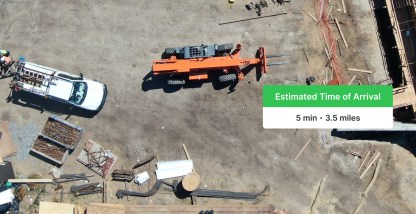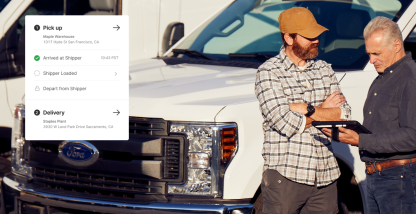For every fleet manager and operator, safety is a priority.
Regardless of the fleet size, the number of drivers, or location, your drivers must have the skills necessary to perform. They also need the right information and tools to help them achieve their best.
An advanced driver assistance system (ADAS) is one of those tools.
The first ADAS feature came on the scene in the 1950s in the form of anti-lock brakes. Since then, ADAS technology has advanced a lot. It can help with trickier parking maneuvers, detect upcoming obstacles, detect common driving errors, help drivers safely assess roads, and prevent accidents.
What is ADAS and why does it matter?
ADAS uses groups of technologies to help drivers engage in complex or difficult maneuvers safely. The most common ADAS features include blind-spot monitoring, lane departure notifications, and collision avoidance alerts. Adaptive cruise control is another. ADAS systems let drivers know if they’re driving too closely to a vehicle or an obstacle. It also alerts if other drivers are tailgating.
Seeing every potential risk isn’t always possible. That’s why driver assistance systems use camera-based technologies with loop-recording features. The features continuously record by overwriting older video with new footage to ensure that the device never misses a second of the drive. It gives the driver a second pair of eyes.
ADAS solutions pair with your vehicle’s AI Dashcam to record live video. The system interprets the incoming data points to analyze what’s happening outside of the vehicle in real time. That includes traffic signs, lane changes, common obstacles, oncoming pedestrians, and the behavior of other drivers.
What are the benefits of ADAS?
We explore the benefits of ADAS below.
Safer driving
Even the most experienced and responsible drivers can be involved in an accident. That’s why installing ADAS in a vehicle is essential.
With blind-spot monitoring, collision avoidance, lane departure warnings, and adaptive cruise control, ADAS can reduce front-to-rear crashes by 50% and reverse crashes by 78%. It protects the driver of the ADAS-operated vehicle as well as the other drivers on the road.
ADAS also helps individual drivers reduce unsafe behaviors. For fleets that use Motive, video footage from the AI Dashcam is automatically uploaded to the Safety Hub. The footage is used to tailor personalized coaching. The driver can see where they might have been driving unsafely, assess their actions, and make smarter choices the next time they’re on the road.
Reduced claims
By decreasing the chance of accidents, ADAS features can reduce the number of claims.
Because ADAS alerts drivers of an impending collision, they’re less likely to be involved in an accident. A study by LexisNexis Risk Solutions shows that vehicles fitted with basic ADAS features had a 19% reduction in property damage claims and a 27% reduction in bodily injury claims.
Reduced liability
On the off chance a driver is involved in an accident, the camera connected to the ADAS will trigger a video recording. This footage can be reviewed by insurance companies or used in legal proceedings to exonerate the driver. If the captured footage proves the fleet driver wasn’t at fault, this footage can be used as evidence to avoid third-party liability.
Improved vehicle health
Driver assistance systems can also help fleet managers assess and maintain the vehicle’s overall health. Taking good care of the vehicle can reduce maintenance costs.
Because ADAS features help drivers prevent accidents, the features also promote better vehicle maintenance. By notifying you when maintenance is needed, ADAS features help extend the life of your equipment. Technologies like adaptive cruise control (ACC) allow drivers to monitor their speed. Adaptive cruise control reduces hard acceleration and braking, maintains tire pressure, and reduces fuel consumption. The system also captures data to assess driving patterns of average speed, brake usage, distance of travel, and more. It all helps fleet managers assess how the vehicle is performing.
With the Motive Vehicle Gateway, fleet managers can keep a closer eye on vehicle health and prevent maintenance problems.
ADAS technologies used by fleets
ADAS technologies were initially developed to help professional drivers and promote effective vehicle fleet management. Here’s how they do it.
- Adaptive cruise control (ACC) detects moving vehicles or stable objects with radar sensors. It warns the driver if they get too close, automatically reducing the speed of the vehicle.
- Blind spot monitoring connected to the vehicle’s cameras shows stable or moving objects from angles the driver might not see.
- Lane departure warning (LDW) pairs video with either laser or infrared sensors to analyze lane markings. The warnings notify the driver if they drift out of the lane. Some advanced versions of this technology will also readjust the vehicle by automatically taking control.
- Electronic stability control (ESC) detects when the driver has lost steering control. Electronic stability control typically kicks in after a harsh maneuver or after the driver has applied brakes to prevent the vehicle from spinning off the road.
- Forward video monitoring records footage of what’s happening on the road ahead. It can be used for training purposes or as evidence when an accident takes place.
- Automatic emergency braking (AEB) automatically applies the brakes to prevent accidents when a potential collision is detected.
Types of driver assistance systems
- Monitoring systems are paired with vehicle cameras to better assess all angles of the vehicle. They identify harsh braking, potential collisions, and traffic signs.
- Warning systems like forward collision warning (FCW) and automatic emergency braking (AEB)assess how close the vehicle is to other objects. They notify the driver so the driver can act to avoid a collision.
- Automated systems essentially take control of the vehicle in the event of a crash, usually by automatically applying the brakes.
- Adaptive systems use motion detectors to assess the distance between vehicles. They adjust the vehicle’s speed when necessary.
Features to look for in ADAS
While most advanced driver assistance systems feature similar technologies, no two are the same. Some will include features to ensure optimum driving safety. Others will only include some basic technologies with the option to add more.
At the most basic level, your ADAS will have blind spot detectors, lane departure warnings, and collision alerts. Driver assistance is a slightly higher level of ADAS. In addition to the most basic features, it includes ACC, AEB, and speed limit control. The highest level systems will include more sophisticated features, such as automatic emergency steering and automatic parking assist.
How Motive complements your ADAS solution
As your partner in accident prevention, our AI Dashcam and Safety Hub assess potential risks on the road. The Motive AI Dashcam instantly detects unsafe driving with unrivaled accuracy and alerts drivers in real time. The camera also records, stores, and analyzes real-time footage to give expert driving advice to your fleet. At the end of a trip, the AI Dashcam automatically coaches correctable behaviors, enabling you to manage your entire safety program and prevent accidents.
Drivers are given a DRIVE risk score that provides a full view of their performance over time. DRIVE dives into the details to assess factors surrounding every unsafe event. It analyzes road conditions, vehicle class, and the behaviors of other drivers on the road.
Motive’s robust safety platform also works alongside most of the major safety features found in your ADAS solution.
Bendix, a trusted safety solutions provider for enterprise fleets, offers safety monitoring and ADAS solutions. Their SafetyDirect Processor hardware collects telematics data. It relies on connectivity from Vehicle Gateway partners like Motive to send the data to a web-based Bendix Safety Portal.
To enhance your ADAS systems, plug into the Motive AI-powered safety platform. You could reduce accidents by up to 30%.
See how Motive can help. Request a demo today.









